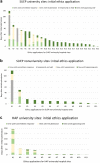Ethical and coordinative challenges in setting up a national cohort study during the COVID-19 pandemic in Germany
- PMID: 37848886
- PMCID: PMC10583323
- DOI: 10.1186/s12910-023-00959-0
Ethical and coordinative challenges in setting up a national cohort study during the COVID-19 pandemic in Germany
Abstract
With the outbreak of severe acute respiratory syndrome coronavirus 2 (SARS-CoV-2), global researchers were confronted with major challenges. The German National Pandemic Cohort Network (NAPKON) was launched in fall 2020 to effectively leverage resources and bundle research activities in the fight against the coronavirus disease 2019 (COVID-19) pandemic. We analyzed the setup phase of NAPKON as an example for multicenter studies in Germany, highlighting challenges and optimization potential in connecting 59 university and nonuniversity study sites. We examined the ethics application process of 121 ethics submissions considering durations, annotations, and outcomes. Study site activation and recruitment processes were investigated and related to the incidence of SARS-CoV-2 infections. For all initial ethics applications, the median time to a positive ethics vote was less than two weeks and 30 of these study sites (65%) joined NAPKON within less than three weeks each. Electronic instead of postal ethics submission (9.5 days (Q1: 5.75, Q3: 17) vs. 14 days (Q1: 11, Q3: 26), p value = 0.01) and adoption of the primary ethics vote significantly accelerated the ethics application process. Each study center enrolled a median of 37 patients during the 14-month observation period, with large differences depending on the health sector. We found a positive correlation between recruitment performance and COVID-19 incidence as well as hospitalization incidence. Our analysis highlighted the challenges and opportunities of the federated system in Germany. Digital ethics application tools, adoption of a primary ethics vote and standardized formal requirements lead to harmonized and thus faster study initiation processes during a pandemic.
Keywords: COVID-19; Ethical approval; Ethics committee; Multicenter study; Pandemic preparedness; Study initiation.
© 2023. BioMed Central Ltd., part of Springer Nature.
Conflict of interest statement
The authors declare no competing interests.
Figures







References
-
- ClinicalTrials.gov. 2022 [Available from: https://clinicaltrials.gov/.
Publication types
MeSH terms
LinkOut - more resources
Full Text Sources
Medical
Miscellaneous

